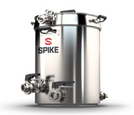Why should you aerate your wort?
At Brewster Bros. Brewing Co., we believe that wort aeration is essential to ensure a complete fermentation cycle. Aeration is simply adding oxygen to wort prior to fermentation. This is an important practice for several reasons:
- Adequate oxygen levels in the wort ensure that the yeast grow and reproduce during fermentation
- Inadequate oxygen levels can cause poor attenuation (how much sugar the yeast eats)
- Adding oxygen to your wort will improve the quality of your beer
In a nutshell, yeast and oxygen need each other. Oxygen promotes healthy, active yeast. Oxygen is essential for the yeast to produce the sterols and fatty acids needed for cell growth. The challenge is to maintain adequate oxygen levels in the wort delivered to the fermentation vessel. Not having proper oxygen levels in the wort that the yeast is feeding on can cause a lag time before fermentation starts, incomplete or stuck fermentation, or excessive ester flavors.
We believe that wort aeration is essential to ensure a complete fermentation cycle.
When should you add oxygen into the wort?
Temperature and specific gravity affect how oxygen dissolves into wort, i.e., colder and less concentrated wort absorbs more oxygen. Since wort loses its oxygen during the boiling process, it must be replenished. Oxygen should be put into the wort after it is cooled and before the yeast is pitched.
How do you add oxygen?
At our brewery, we inject the oxygen into the wort in the transfer line after the plate chiller using an oxygen stone. Sterile air can also be injected. Ideally, a range of 8 to 10 parts per million (ppm) dissolved oxygen is achieved. The injection rate of air or oxygen must be monitored to avoid too little oxygen or too much oxygen.
What methods should you use for aeration?
There are several methods for aerating wort. As a home brewer for 15 years before opening the brewery, I aerated my wort using a few different methods.
- When using my mini-development system, I did the injection with an oxygen stone in the line. We currently do this with small batches at the brewery.
- A common method used by homebrewers is infusing air or oxygen into the wort after it has been cooled and transferred to the fermenter. This method uses aquarium pumps and oxygen stones.
- Other methods I used in homebrewing were splashing during the transfer of the cooled wort to the fermenter or rocking/shaking the carboy (be careful if you are using glass carboys). The goal of splashing and shaking is to maximize the air exposure of the wort.
Whatever method you choose, be sure to aerate your wort!
James Stirn
Brewmaster and Co-founder at Brewster Bros Brewing Co.
Chippewa Falls, WI












